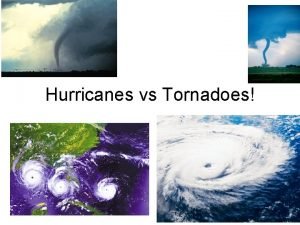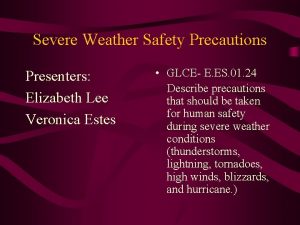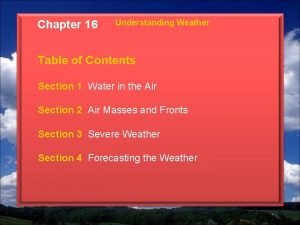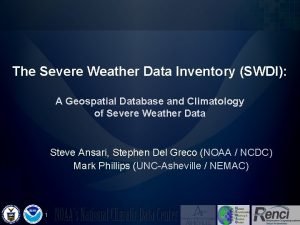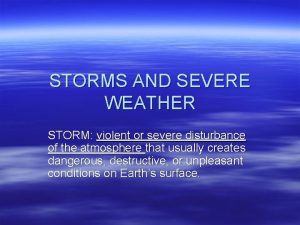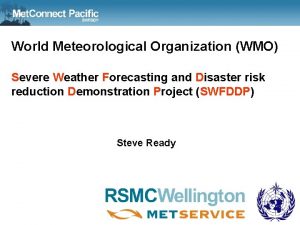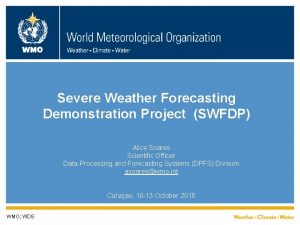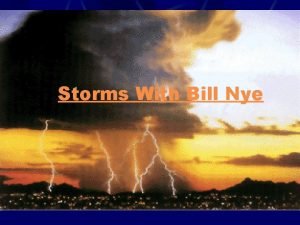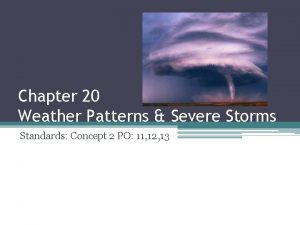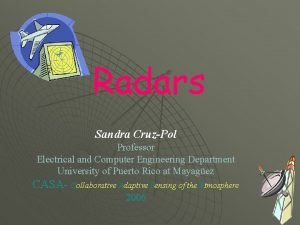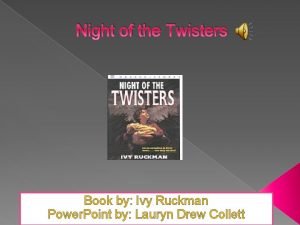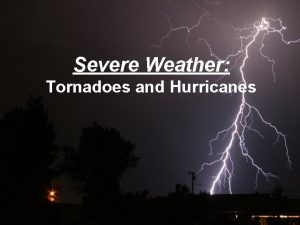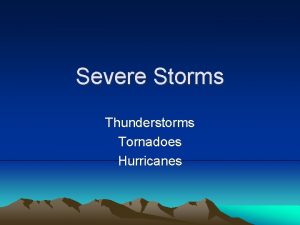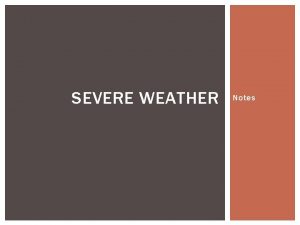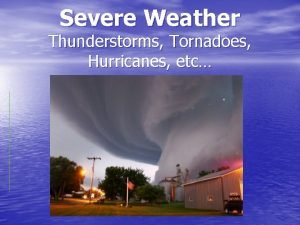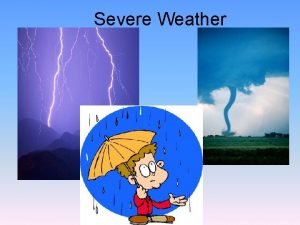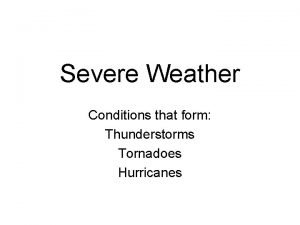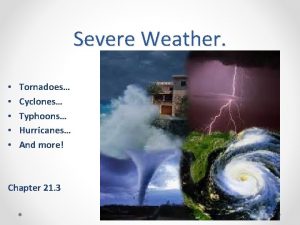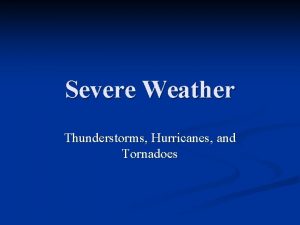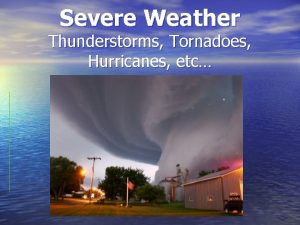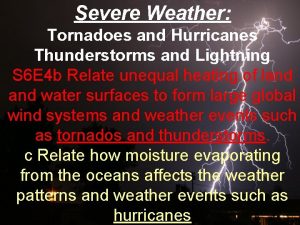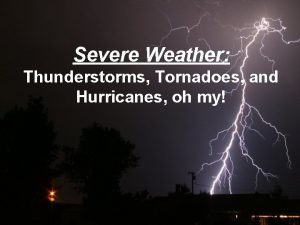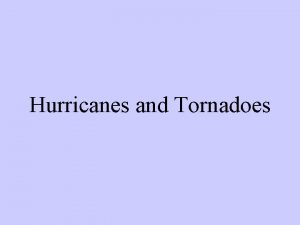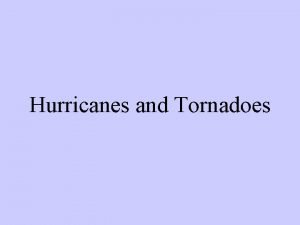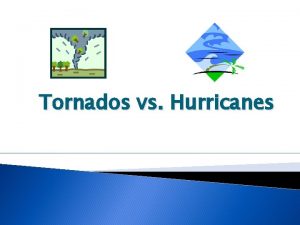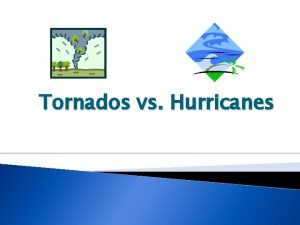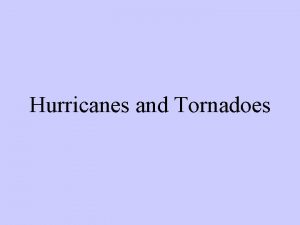Severe Weather Hurricanes Tornadoes All Hurricanes are low



















- Slides: 19

Severe Weather Hurricanes Tornadoes

All Hurricanes are low pressure storm systems

What makes a hurricane different from a tornado? • • • Hurricanes Form over warm water Last a long time Hit a large area Most of the damage comes from the storm surge Occur in late summer and early fall • • Tornadoes Form when c. P and m. T air masses meet over land (most often) Short-lived Cover a small area Most of the damage comes from the winds (can be over 300 mph!) • Occur in spring and early summer

Severe Weather Notes

Thunderstorms • Intense weather systems that produce: 1. Strong winds 2. Heavy rain 3. Lightning and thunder • • Occur along cold fronts Cumulonimbus clouds - storm clouds

When do Thunderstorms occur? • Two atmospheric conditions required for thunderstorms 1 - Moist warm air near the Earth’s surface 2 - Unstable atmosphere cold air surrounding a rising air mass)

Lightning An electric discharge that occurs between a positively charged area and a negatively charged area Can occur: • 1. Cloud to cloud 2. Cloud to earth 3. In the same cloud • http: //www. chaseday. com/lightning. htm

Thunder • The sound that results from rapid movement of air along a lightning strike • Occurs during Thunderstorms • Lightning first – then thunder because light travels faster than sound.

Tornado • Is a small, spinning column of air that has high wind speed with low pressure that touches the ground Formation- http: //dsc. discovery. com/tv/storm-chasers/ • Wind moving in 2 directions cause the air to spin with cloud, creating a funnel • When funnel cloud touches the surface, it is now a tornado • Winds- 120+ km/hr (up to 300 MPH)

Hurricanes • A large rotating, tropical weather system with wind speeds of at least 120 km/h • Most powerful storms on earth • Form over warm, tropical oceans • Category 1 -5 • Storm surge and flooding in coastal areas • LIKE LONG ISLAND’S SOUTH SHORE!!!!! – Superstorm Sandy video compilation • http: //safeshare. tv/w/z. Jf. QSoqh. MN

Hurricane formation • Thunderstorms over tropical oceans meet with winds in different directions • Spin counter clockwise in Northern Hemisphere and clockwise in the southern due to the Coriolus Effect (Spin of earth) • Warm moist air fuels hurricanes • Must have LOW pressure • Hurricanes die once they move over colder water or land

Blizzards • Huge winter storms with high winds, heavy snow and sometimes lightning and thunder. • Ice storms can occur as rainfall begins to freeze and can disrupt electric and phone service. • Can cause power outages and dangerous travel conditions. Frostbite and hypothermia.

Severe Weather Safety • Listen to the radio/TV during storm for information • Lightning is attracted to tall objects if outside stay away from trees or lay down if in the open • Stay out of bodies of water during a storm

Climate Change • Scientists around the world believe that the Earth’s temperature is gradually increasing. • Global warming – is the name for the gradual increase of average temperatures worldwide. • Scientists believe that an increase in CO 2 emissions is causing the temperature to rise.

Average Yearly Temperature Global Warming in 15 seconds - video

What causes Global Warming? • When Carbon Dioxide CO 2 is trapped in the atmosphere, it causes the GREENHOUSE EFFECT • Water Vapor and Carbon Dioxide in the atmosphere trap heat and don’t let it escape into space. “These greenhouse gases act like a blanket”

What human activities cause excess CO 2 (Global Warming) • Breathing • Burning Fossil Fuels – such as coal, oil, gas • Deforestation (cutting down trees that use up CO 2 when they photosynthesize)

What effect does Global Warming have on the earth? • Melting Ice Caps in the Arctic and Antarctic which cause rising sea levels • Plants/trees growing season is affected • Animals like polar bears have to relocate due to loss of ice (habitat) • Ocean waters are warmer causing large cylconic (hurricanes) storms and death to some sea life.

How can we reduce CO 2 emissions? • Burn less fossil fuels (NON-RENEWABLE) – Use less electricity (shut off lights, unplug appliances, buy energy efficient appliances) – Use less fuel (gas for cars) by carpooling, taking public transportation, smaller cars • Use Renewable sources of energy – Use solar energy to produce electricity – Use wind energy to produce electricity – Use water energy (dams) to produce electricity – Use geothermal energy to heat our homes
 Comparison words
Comparison words Hurricanes vs tornadoes
Hurricanes vs tornadoes Difference between cake and brownie
Difference between cake and brownie Antigentest åre
Antigentest åre Chapter 20 weather patterns and severe storms
Chapter 20 weather patterns and severe storms Severe weather safety precautions worksheet
Severe weather safety precautions worksheet Chapter 16 understanding weather answer key
Chapter 16 understanding weather answer key Severe weather data inventory
Severe weather data inventory Hurricane causes
Hurricane causes Wmo severe weather
Wmo severe weather Swfdp
Swfdp Bill nye tornadoes
Bill nye tornadoes Chapter 20 weather patterns and severe storms
Chapter 20 weather patterns and severe storms Middle = low + (high - low) / 2
Middle = low + (high - low) / 2 Low dominance and low sociability
Low dominance and low sociability Low accuracy low precision
Low accuracy low precision Low voltage hazards
Low voltage hazards Name a line containing point a
Name a line containing point a Sandra cruz denton tx
Sandra cruz denton tx Book night of the twisters
Book night of the twisters

